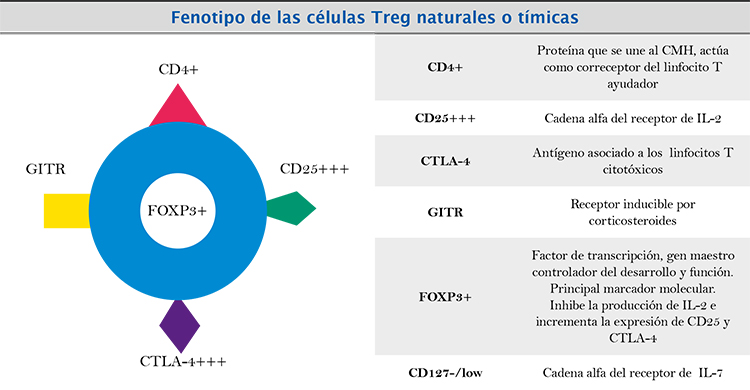Células reguladoras en cáncer de piel melanoma y no melanoma
Palabras clave:
cáncer de piel, melanoma, células T reguladoras, carcinoma basocelular, carcinoma escamocelularResumen
Las células T reguladoras (Treg) CD4+CD25+FOXP3+ son cruciales para el
mantenimiento de la tolerancia y la prevención de la autoinmunidad. Su deficiencia se asocia con enfermedades autoinmunitarias y alergias, y su aumento se
relaciona con el cáncer. La manipulación de las Treg es un objetivo de los estudios de inmunología del cáncer, debido a los potenciales efectos antitumorales.
Las células Treg se producen en el timo y en la periferia. La radiación ultravioleta es capaz de suprimir la respuesta inmunitaria en la piel, entre otros mecanismos, por la inducción de las Treg, y esto se asocia al desarrollo de cáncer de
piel melanoma y no melanoma.
En este artículo se revisan los aspectos esenciales de las células Treg, su relación con la radiación ultravioleta y el cáncer, específicamente el cáncer de piel
melanoma y no melanoma.
Biografía del autor/a
Cristina Escobar
Médica, residente de segundo año, Dermatología, Universidad de Antioquia.
Margarita María Velásquez
Dermatóloga, Doctora en Ciencias Básicas Biomédicas, énfasis en Inmunología. Jefe Sección de Dermatología, Grupo Investigación Dermatológica, GRID. Universidad de Antioquia.
Referencias bibliográficas
2. Jiang H, Chess L. Regulation of immune responses by T cells. N Engl J Med. 2006;354:1166-76.
3. M.G. Label, R.Kolliker-Frers,A.Woscoff, P.Troielli. Regulación de la respuesta inmune. Células T reguladoras-supresoras. Parte I. Dermatología Argentina. 2005; 11:132- 7
4. Beissert S, Schwarz A, Schwarz T. Regulatory T cells. J Invest Dermatol. 2006; 126:15-24.
5. Fehérvari Z, Sakaguchi S. CD4 + Tregs and immune control. J Clin Invest. 2004; 114:1209-17.
6. Lima HC. Role of regulatory T cells in the development of skin diseases. An Bras Dermatol. 2006; 81:269-81.
7. Melencio L, McKallip RJ, Guan H, Ramakrishnan R, Jain R, Nagarkatti PS, et al. Role of CD4(+)CD25(+) T regulatory cells in IL-2-induced vascular leak.. Int Immunol. 2006; 18:1461-71.
8. Wang HY, Wang RF. Regulatory T cells and cancer. Curr Opin Immunol. 2007; 19:217-23.
9. Luis J, Parias G, Giraldo VED, Velásquez-Lopera MM. Foxp3: Controlador maestro de la generación y función de las células reguladoras naturales. Inmunología 2010; 291-11.
10. Dudda JC, Perdue N, Bachtanian E, Campbell DJ. Foxp3+ regulatory T cells maintain immune homeostasis in the skin. J Exp Med. 2008; 205:1559-65.
11. Polansky JK, Kretschmer K, Freyer J, Floess S, Garbe A, Baron U, et al. DNA methylation controls Foxp3 gene expression. Eur J Immunol 2008; 38(6):1654-63.
12. Cavanagh LL, Halliday GM. Dendritic epidermal T cells in ultraviolet-irradiated skin enhances skin tumor growth by inhibiting CD4+ T-cell-mediated immunity. Cancer Res J. 1996; 56:2607-15
13. Fu B-Mang, He X-Shun, Yu S, Hu A-bin, Zhang J, Ma Y, et al. A tolerogenic semimature dendritic cells induce effector T-cell hyporesponsiveness by activation of antigen-specific CD4+CD25+ T regulatory cells that promotes skin allograft survival in mice. Cell Immunol 2009; 261:69-76.
14. Jang TJ. Prevalence of Foxp3 positive T regulatory cells is increased during progression of cutaneous squamous tumors. Yonsei Med J. 2008; 49:942-8.
15. D’Ambrosio D. Regulatory T cells: How do they find their space in the immunological arena?. Semin Cancer Biol. 2006; 16:91-7.
16. Clark RA. Skin-resident T cells: The ups and downs of onsite immunity. J Invest Dermatol. 2010; 130:362-70.
17. Beyer M, Schultze JL. Regulatory T cells in cancer. Blood. 2006; 108:804-11.
18. Wang R-F. CD8+ regulatory T cells, their suppressive mechanisms, and regulation in cancer. Human Immunol 2008; 69:811-4.
19. Birch KE, Reed JR, Akbar AN, Rustin MHA, Birch K. The immunomodulatory effects of regulatory T cells: Implications for immune regulation in the skin. Br J Dermatol. 2005; 152:409-17.
20. Prendergast GC, Metz R. IDO recruits Tregs in melanoma A side-by-side comparison of. Cell Cycle. 2009; 8:1818-22.
21. Ilkovitch D. Role of immune-regulatory cells in skin pathology. J Leukoc Biol. 2010; 89:1-9.
22. Gruijl FR. Ultraviolet radiation and tumor immunity. Methods (San Diego, Calif.). 2002; 28:122-9.
23. Beissert S, Loser K. Molecular and cellular mechanisms of photocarcinogenesis. Photochem Photobiol. 2008; 84:29-34.
24. Wang L, Toda M, Saito K, Hori T, Horii T, Shiku H, et al. Post-immune UV irradiation induces Tr1-like regulatory T cells that suppress humoral immune responses. Int Immunol. 2008; 20:57-70.
25. Rana S, Byrne SN, MacDonald LJ, Chan CY-Y, Halliday GM. Ultraviolet B suppresses immunity by inhibiting effector and memory T cells. [Internet]. Am J Pathol. 2008; 172:993-1004.
26. Noonan FP, Muller HK, Fears TR, Kusewitt DF, Johnson TM, De Fabo EC. Mice with genetically determined high susceptibility to ultraviolet (UV)-induced immunosuppression show enhanced UV carcinogenesis. J Invest Dermatol. 2003; 121:1175-81.
27. Maeda A, Beissert S, Schwarz T, Schwarz A. Phenotypic and functional characterization of ultraviolet radiation-induced regulatory T cells. J Immunol 2008; 180:3065-71.
28. Loser K, Apelt J, Voskort M, Mohaupt M, Balkow S, Schwarz T, et al. IL-10 controls ultraviolet-induced carcinogenesis in mice. J Immunol 2007; 179:365-71
29. Schwarz a, Beissert S, Grosse-Heitmeyer K, Gunzer M, Bluestone JA, Grabbe S, et al. Evidence for functional relevance of CTLA-4 in ultraviolet-radiation-induced tolerance. J Immunol 2000; 165:1824-31.
30. Schwarz A, Maeda A, Ständer S, van Steeg H, Schwarz T. IL-18 reduces ultraviolet radiation-induced DNA damage and thereby affects photoimmunosuppression. J Immunol 2006; 176:2896-901.
31. Meeran SM, Katiyar S, Elmets CA, Katiyar SK. Interleukin-12 deficiency is permissive for angiogenesis in UV radiationinduced skin tumors. Cancer Res. 2007; 67:3785-93.
32. Schwarz T. Regulatory T cells induced by ultraviolet radiation. Int Arch Allergy Immunol. 2005; 445:1-7.
33. Loser K, Beissert S. Regulation of cutaneous immunity by the environment: An important role for UV irradiation and vitamin D. Int Immunopharmacol. 2009; 9:587-9
34. Ghoreishi M, Bach P, Obst J, Komba M, Fleet JC, Dutz JP. Expansion of antigen-specific regulatory T cells with the topical vitamin D analog calcipotriol. J Immunol 2009; 182:6071-8.
35. Katiyar S. Interleukin-12 and photocarcinogenesis. Toxicol Appl Pharmacol. 2007; 224:220-7
36. Meeran SM, Mantena SK, Meleth S, Elmets CA, Katiyar SK. Interleukin-12-deficient mice are at greater risk of UV radiation-induced skin tumors and malignant transformation of papillomas to carcinomas. Mol Cancer Ther. 2006; 5:825-32.
37. Meeran SM, Mantena SK, Katiyar SK. Prevention of ultraviolet radiation-induced immunosuppression by (-)-epigallocatechin-3-gallate in mice is mediated through interleukin 12-dependent DNA repair. Clin Cancer Res. 2006; 12:2272-80.
38. Piersma SJ, Welters MJP, van der Burg SH. Tumor-specific regulatory T cells in cancer patients. Human Immunol. 2008; 69:241-9.
39. Antony PA, Restifo PN CD4+ CD25+ T regulatory cells, immunotherapy of cancer, and interleukin-2 . J Immunother. 2005; 28:120-8.
40. Moodycliffe AM, Nghiem D, Clydesdale G, Ullrich SE. Immune suppression and skin cancer development: Regulation by NKT cells. Nat Immunol. 2000; 1:521-5
41. Ha T-Y. The role of regulatory T cells in cancer. Immune Netw. 2009; 9:209-35.
42. Baecher-Allan C, Anderson DE. Regulatory cells and human cancer. Semin Cancer Biol. 2006; 16:98-105.
43. Wolf AM, Wolf D, Steurer M, Gastl G, Gunsilius E, Grubeckloebenstein B. Increase of regulatory T cells in the peripheral blood of cancer patients. Clin Cancer Res. 2003; 9:606-12.
44. Cao X. Regulatory T cells and immune tolerance to tumors. Immunol Res. 2010; 46:79-93.
45. Attia P, Maker AV, Haworth LR, Rogers-Freezer L, Rosenberg SA. Inability of a fusion protein of IL-2 and diphtheria toxin (Denileukin Diftitox, DAB389 IL-2, ONTAK) to eliminate regulatory T lymphocytes in patients with melanoma. J Immunother. 2005; 28:582-92.
46. Wolff K, Goldsmith LA, Katz SI. Fitzpatrick’s dermatology in general medicine. 7th edition. : Mc Graw Hill Medical; 2008. USA.
47. Baumgartner J, Wilson C, Palmer B, Richter D, Banerjee A, McCarter M. Melanoma induces immunosuppression by upregulating FOXP3(+) regulatory T cells. J Surg Res. 2007; 141:72-7.
48. Correll A, Tuettenberg A, Becker C, Jonuleit H. Increased regulatory T-cell frequencies in patients with advanced melanoma correlate with a generally impaired T-cell responsiveness and are restored after dendritic cell-based vaccination. Exp Dermatol. 2010; 19:213-21.
49. Mahnke K, Schönfeld K, Fondel S, Ring S, Karakhanova S, Wiedemeyer K, et al. Depletion of CD4+CD25+ human regulatory T cells in vivo: Kinetics of Treg depletion and alterations in immune functions in vivo and in vitro.. Int J Cancer. 2007; 120:2723-33.
50. Tuettenberg A, Becker C, Huter E, Knop J, Enk AH, Jonuleit H. Induction of strong and persistent MelanA/MART-1- specific immune responses by adjuvant dendritic cell-based vaccination of stage II melanoma patients. Int J Cancer. 2006; 118:2617-27.16
51. Maeda A, Schneider SW, Kojima M, Beissert S, Schwarz T, Schwarz A. Enhanced photocarcinogenesis in interleukin-12- deficient mice. Cancer Res. 2006; 66:2962-9.
52. Welsh MM, Applebaum KM, Spencer SK, Perry AE, Karagas MR, Nelson HH. CTLA4 variants, UV-induced tolerance, and risk of non-melanoma skin cancer. Cancer Res. 2009; 69:6158-63.
53. Euvrard S, Kanitakis J, Claudy A. Skin cancers after organ transplantation. N Engl J Med. 2003; 348:1681-91
54. Dreno B. Skin cancers after transplantation. Nephrol Dial Transplant. 2003; 18:1052-8
55. Kaporis HG, Guttman-Yassky E, Lowes MA, Haider AS, Fuentes-Duculan J, Darabi K, et al. Human basal cell carcinoma is associated with Foxp3+ T cells in a Th2 dominant microenvironment. J Invest Dermatol. 2007; 127:2391-8.
Cómo citar
Descargas

Descargas
Publicado
Cómo citar
Número
Sección
| Estadísticas de artículo | |
|---|---|
| Vistas de resúmenes | |
| Vistas de PDF | |
| Descargas de PDF | |
| Vistas de HTML | |
| Otras vistas | |






